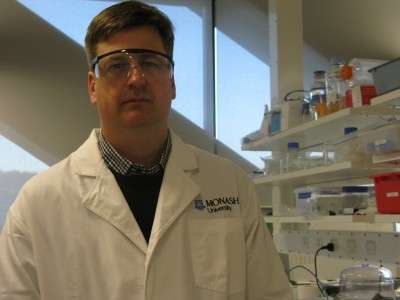Joint research builds stronger scaffold

(Medical Xpress)—A new biomaterial that enhances the ability of stem cells to regenerate into nerves and body parts is the direct result of collaborative work between Monash University and the University of Warwick.
Other biomedical "scaffold" materials, which act as templates for tissue regeneration, already exist but they can't communicate effectively with the cells they are trying to influence.
The Monash and Warwick researchers have created a more advanced material that targets specific cells and provides clear signals to these cells to enhance regeneration. The biomaterial also dissolves once repair is well underway and its stealth coating makes it invisible to the immune system.
Associate Professor John Forsythe from the Department of Materials Engineering at Monash said this research idea resulted from a workshop he attended at Warwick in 2012.
"I first met Warwick's Associate Professor Andrew Dove at the workshop, where we discussed the need for more effective scaffolding materials for regenerative medicine," Associate Professor Forsythe said.
"Warwick has the specialised facilities and knowledge to synthesise these materials, whereas Monash has the expertise in nanofabrication and applying them to biomedical research, so together we have very complementary strengths.
"Now we have developed this material, the next stage is to conduct further research to determine its effectiveness in models of Parkinson's disease."
Dr Francesca Ercole, a postdoctoral researcher with Associate Professor Forsythe, spent three months at Warwick working in Associate Professor Dove's lab in early 2013.
"At Warwick I learnt how to make and customise the scaffolding material for our project, and organised for these materials to be tested for their effectiveness at Monash," Dr Ercole said.
"My experience at Warwick was invaluable as I learnt new techniques that could only be gained working alongside Associate Professor Dove."
Associate Professor Dove from Warwick's Department of Chemistry has travelled to Monash four times for the project and other sustainable chemistry activities supported by the Monash Warwick Alliance.
"The Monash Warwick Alliance funded Dr Ercole's extended stay and it has also helped us visit each other's labs to develop a strong collaborative relationship, which is essential for working together," Associate Professor Dove said.
"Without the Alliance's support, it would have been very difficult, if not impossible, to get this project off the ground and moving forward so effectively."
The success of this project has prompted the researchers to investigate whether a Monash Warwick Joint PhD student could join the team.
This research was published last month in Polymer Chemistry. The team hopes to publish further work on this project later in the year.
More information: "Surface grafted poly(ε-caprolactone) prepared using organocatalysed ring-opening polymerisation followed by SI-ATRP." Francesca Ercole. Polym. Chem., 2014,5, 2809-2815. DOI: 10.1039/C3PY01701J
















